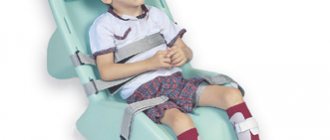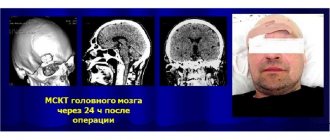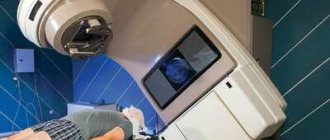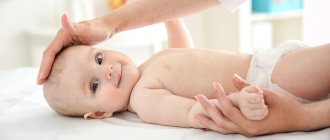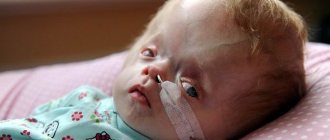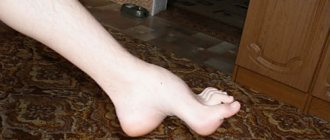The term cerebral palsy usually refers to a group of symptom complexes manifested by disturbances in the motor sphere. These disorders occur due to damage to the central nervous system. Cerebral palsy can occur in a mild, unnoticeable form or have a severe course that requires constant treatment.
Cerebral palsy refers to diseases of the nervous system and according to ICD 10 the disease is assigned code G80, there are also subparagraphs indicating a form of paralysis. Cerebral palsy is a non-progressive disease of the nervous system, but if left untreated, the child will lag far behind in development, both mental and physical, from his peers.
Rehabilitation measures begun in early childhood can achieve excellent results; of course, everything depends on the form of the disease. Children with cerebral palsy generally live to old age and can have children of their own.
Causes of cerebral palsy
According to statistics, from 6 to 12 children for every thousand newborns are born with a diagnosis of cerebral palsy and many people think that this disease is inherited, but the direct cause of the development of cerebral palsy in the fetus is a pathological disorder of the brain structures, which leads to insufficient oxygen supply. The risk of developing cerebral palsy increases under the influence of the following provoking factors:
- Infectious diseases of the mother
throughout pregnancy, these primarily include the herpes virus, cytomegalovirus, and toxoplasmosis. - Abnormal development of parts of the brain during intrauterine development of the fetus.
- Incompatibility of the blood of mother and child
- Rh - a conflict leading to hemolytic disease of newborns. - Chronic fetal hypoxia
during pregnancy and childbirth. - Endocrinological and acute somatic diseases of the mother
. - Difficult childbirth
, prolonged labor, injuries to the child while passing through the birth canal. - In the early perinatal period, cerebral palsy can be caused by toxic damage to the body from severe poisons, infectious diseases that affect the parts and cortex of the brain.
A major role in the development of cerebral palsy is given to oxygen starvation of the brain, which occurs when the fetus’s uterus is incorrectly positioned in the body, prolonged labor, or the umbilical cord entwined in the cervix. Most children show the influence of several factors at once, one of which is considered leading, while others enhance its negative impact.
Why does this pathology occur?
The hyperkinetic form of cerebral palsy, the causes of which are varied, occurs as a result of the influence of perinatal and prenatal factors on the child.
- Hypoxia during pregnancy. When the fetus does not receive enough oxygen for a long time, its nervous system cannot fully develop; its already formed nerve cells begin to die.
- The impact of toxins on the body of a pregnant woman. Toxic substances modify the cells of the fetus, and abnormalities occur in its brain (they can similarly affect other organs).
- Fetal infection. Infections that penetrate the placental barrier, like toxins, can affect nerve cells.
- Metabolic disorders in the fetus. They provoke nutritional deficiency, as a result of which the growth and development of the baby slows down.
- Rhesus conflict between mother and child.
- Birth injuries.
Cerebral palsy (a hyperkinetic form of the disease) is observed in full-term babies who have normal body weight or its deficiency at birth, as well as in premature infants.
Forms of cerebral palsy and their characteristics
The severity of motor disorders in children with cerebral palsy can be completely different and therefore the disease is usually divided into forms.
- The hyperkinetic form
is diagnosed if the baby has unstable muscle tone; on different days it can be increased, normal or decreased. Normal movements are awkward, sweeping, involuntary movements of the limbs, hyperkinesis of the facial muscles are observed. Disorders in the motor sphere are often accompanied by pathologies of speech and hearing, while the mental activity of such children is at an average level. - The atonic-astatic form
develops mainly with damage to the cerebellum and frontal lobes. It is characterized by extremely low muscle tone, which prevents the child from maintaining an upright position. Mental development occurs with a slight delay, but in some cases mental retardation is detected in children. - Spastic diplegia
is the most common form. Muscle functions are impaired on both sides, with the lower limbs being more affected. In children, contractures develop from an early age, and deformities of many joints and the spine are detected. Mental and speech development is delayed, strabismus and speech pathologies are often detected; a child with this form, with appropriate rehabilitation measures, becomes socially adapted. - Spastic tetraparesis
(tetraplegia) is one of the most severe forms of cerebral palsy; the disease is caused by significant abnormalities in damage to most parts of the brain. Paresis is observed in all extremities, the neck muscles can be constantly relaxed, and such children often have below average mental development. In almost half of the cases, tetraparesis is accompanied by epileptic seizures. Children with this form can rarely move independently; their understanding of the world around them is difficult due to problems with speech and hearing. - The atactic form
is rare; during its development, disturbances in the coordination of all movements and maintaining balance are observed. The child often has tremors of the hands, which is why he is unable to perform normal activities. Mental retardation in most cases is moderate. - The spastic-hyperkinetic form
(dyskinetic form) reveals a combination of involuntary movements, increased muscle tone and paresis with paralysis. Mental development is at an age-appropriate level; such children successfully graduate not only from school, but also from college. - Right-sided hemiparesis
refers to the hemiplegic form, in which one side of the hemisphere is affected. The muscle tone of the limbs on one side is increased, paresis and contractures develop. The muscles of the arm suffer the most, and involuntary movements of the upper limb are noted. With this form there may be symptomatic epilepsy and disturbances in mental development.
Signs and symptoms
Symptoms of muscle pathologies in cerebral palsy depend on the area and degree of brain damage.
The main signs are represented by the following violations:
- Tension of different muscle groups.
- Spasmodic involuntary muscle contractions in the limbs and throughout the body.
- Pathological disturbances when walking.
- Limitation of general mobility.
In addition to these signs, children exhibit pathologies of visual, auditory and speech function, and disorders of mental and mental activity. Signs of the disease also depend on the age of the baby. Cerebral palsy does not progress, since the lesion is localized and does not spread to new areas of nervous tissue as the child grows older.
The apparent worsening of the disease is explained by the fact that the symptoms are less noticeable at a time when the baby is not yet walking or attending preschool institutions.
Let's look at the signs of cerebral palsy in an infant:
- In newborns with cerebral palsy,
you can pay attention to the fact that the baby moves only the limbs of one side of the body, the opposite ones are usually pressed to the body. A newborn child with cerebral palsy turns his head in the opposite direction when trying to put his clenched fist into his mouth. Difficulties also arise when the mother tries to spread her legs to the sides or turn the baby’s head. - One month
. At one month you may notice that the baby still does not smile, cannot hold his head even for a few seconds, and cannot focus his gaze on a specific object. The baby is restless, the sucking and swallowing reflex is often difficult, and there are often convulsions and involuntary shudders. - 3 months
. Children with cerebral palsy at three months may experience preservation of absolute reflexes, that is, those that are present at birth, but should normally disappear by three months. These are stepping movements when the baby, leaning on his legs, is able to take several steps. Also, the palmar reflex - when you press your fingers on your palm, the child involuntarily opens his mouth. At three months, the baby, also with normal development, is already trying to roll over, and in a lying position he confidently holds his head. - 4 months
. A baby at 4 months should already consciously respond to his mother, pronounce sounds, smile, actively move his arms and legs, take a toy and examine nearby objects. A child with cerebral palsy will be lethargic, may arch his body when crying, and will pick up objects exclusively with one hand. - 6 months
. At six months of life, most babies pronounce individual syllables, can roll over on their own, hold their heads well, swallow from a spoon or mug, and try to crawl. The child reacts differently to his mother and relatives. The presence of any disorders is indicated not only by muscle hypertonicity, but also by their weakness, constant restlessness of the baby, and poor sleep. - 9 months
. At 9 months, a child with cerebral palsy does not show interest in walking, sits poorly, falls on his side, and is unable to hold objects for a long time. With normal development at this age, the baby should already be able to get up, move around the crib or with the support of adults around the room. The child already recognizes his favorite toys and tries to name them by pronouncing individual sounds or syllables.
Of course, not all signs of developmental delay are symptoms of cerebral palsy. But parents must remember that it depends only on them how the child will live in later life - according to statistical data, more than half of the children with cerebral palsy identified and treated in the first year of life subsequently differ from their peers in only a few disorders.
Diagnostics
When diagnosing, the doctor must not only examine the child and carry out a number of diagnostic procedures, but also need to find out how the pregnancy and childbirth proceeded.
Cerebral palsy must be differentiated from other diseases; often, if there is a deterioration in already mastered skills, this indicates completely different pathologies. The examination is based on MRI and computed tomography data. During pregnancy, abnormalities in brain development can be detected using ultrasound, but doctors will not say that the child will have cerebral palsy. Based on the identified violations, one can only assume that the baby will develop developmental delays after birth and, based on this, conduct an appropriate examination. The presence of herpes and cytomegalovirus infections should also alert you.
Diagnosis of the disease
Recognition and treatment of hyperkinetic behavior disorder in children requires a comprehensive approach. The diagnosis is made based on a number of studies, which include:
- determination of neurological and psychological status using various techniques;
- assessment of the child’s medical history, environment, environment and living conditions;
- consultation with an ophthalmologist, psychiatrist, geneticist;
- electroneurophysiological examination;
- magnetic resonance or computed tomography of the brain;
- complex of laboratory tests.
The main task at the diagnostic stage is not only to identify the characteristic signs of hyperkinesis, but also to exclude other pathologies that may give a similar clinical picture, for example, epilepsy, Schilder-Addison syndrome.
Treatment
It is necessary to be treated immediately after diagnosis and it is best if the entire range of therapeutic measures is carried out in the first year of life. In the first year of life, a child’s nerve cells are able to fully recover; at an older age, only rehabilitation and adaptation of the child to social life is possible.
Exercise therapy for cerebral palsy
A child needs a special group of physical exercises every day. Under the influence of exercises, muscle contractures are reduced, the stability of the psycho-emotional sphere is formed, and the muscle corset is strengthened.
From a lying position, the child should be encouraged to rest his feet on firm support.
From a lying position on his stomach, you need to pull the baby up by the arms, making springy movements in all directions.
The child is on her knees, the mother should stand behind her and, fixing the baby’s legs, try to get him to move forward.
Sets of exercises must be selected in consultation with a doctor; their effectiveness depends largely on the perseverance of the parents.
The video shows a set of exercise therapy exercises for children with cerebral palsy:
Massage
Massage for cerebral palsy is not recommended to begin earlier than one and a half months and should only be performed by a specialist. The wrong choice of massage technique can lead to increased muscle tone. Properly conducted massages facilitate the restoration of functions and have a general strengthening and healing effect.
A set of exercises for cerebral palsy
Drug treatment
Neuroprotectors are prescribed as medications - Cortesin, Actovegin, muscle relaxants. Vitamin complexes and drugs that improve metabolic processes in the body are widely used. In some cases, sedative therapy is prescribed.
Botulinum toxin preparations are injected locally into muscles with increased tone in children with spastic disorders. Toxins relax muscles and increase their range of motion. The drugs are effective for three months and then need to be re-injected. The use of botulinum toxins is recommended for the treatment of those children who have a limited group of disorders. Botulinum toxins include Botox, Dysport
Speech therapy work for cerebral palsy
Classes with a speech therapist for children with cerebral palsy are very important. Correct speech delivery is the key to his further successful learning and communication with peers. Classes are selected based on the form of speech impairment in cerebral palsy.
Operations for cerebral palsy
Surgical intervention for cerebral palsy is performed in older children if there is no effect from the therapy. Surgical interventions are most often aimed at treating contractures, which helps the child become more active in movement.
Taping
Taping is the fixation of a special patch on a certain area of the body for several days. Its purpose is to reduce pain and increase mobility of the affected area of the body. With the help of kinesio tapes, the directions of movements are corrected, blood circulation is improved, and muscle endurance is increased.
New and non-standard treatment methods
Every year, new methods of treating cerebral palsy appear, some of them are really effective, others help only a limited number of patients.
Osteopathy
This is a manual impact on various parts of the body in order to restore movement disorders. Osteopathy improves blood circulation in the brain, restores natural connections between nerve endings and the muscles they regulate.
Only a qualified specialist knows the technique of osteopathy, so you need to consider all clinic options before deciding on osteopathic treatment for cerebral palsy in your child.
Stem cell treatment.
Transplanting stem cells into a child’s body allows us to stimulate the restoration of nervous tissue and thus the damaged areas of the brain begin to function normally. The introduction of stem cells is effective, even if such treatment is started only in adolescence.
Hippotherapy
Therapeutic horse riding. LVE helps to increase the child’s physical activity, helps restore motor functions, and develops new skills. Communication with horses is also useful for the psycho-emotional state of the child - children with cerebral palsy who have completed a course of hypotherapy become much calmer, worry less about their condition, and learn to adapt in society.
Achilloplasty
Aimed at reducing muscle contractures. After the operation, the range of movements expands; surgical intervention is carried out no earlier than 4-5 years.
Equipment for children with cerebral palsy
Depending on the degree of impairment of motor functions, children with cerebral palsy need special devices that help them move and restore impaired functions.
- Strollers
are necessary for children who cannot move independently. Special strollers have been developed for home and walking; modern models have an electric drive, which ensures ease of use. The PLIKO stroller is a stroller, it is light in weight and also easy to fold. The stroller is designed taking into account the normal physiological position of a child with cerebral palsy. Thanks to its design features, the “Liza” stroller can also be used for children and teenagers. - A walker
is required if the child walks but cannot maintain balance. With the help of walkers, children not only learn to walk, but also learn to coordinate their movements. - Exercise machines
– this group includes any device that helps a child develop his activity and learn certain skills. - Bicycles
for cerebral palsy are of a three-wheel design and with a handlebar not connected to the pedals. The bicycle must have attachments for the body, shins and hands, and a handle for pushing is required. Fastening on the foot pedals allows you to develop movements in the legs and strengthens the muscles. - Exercise bikes
strengthen leg muscles, help consolidate motor skills, and build endurance. Exercising on an exercise bike helps strengthen the immune system - Hippo simulators
are devices that simulate all the movements of a horse while walking or running. That is, on a hippo trainer, the child’s body sways back, forward and to the sides. Hippo machines allow you to strengthen your back muscles, form beautiful posture, and improve flexibility in your joints. - Suits
for the treatment of cerebral palsy are designed like space suits, that is, the body in them is in zero gravity. The material used for the costumes helps to secure the body tightly and at the same time relax the muscles, which allows the child to take his first steps. The pneumatic chambers in the suit are inflated and stimulate the work of different muscle groups, transmitting impulses from them to the cerebral cortex.
- Orthopedic shoes
and orthoses are necessary to suppress hyperkinesis and the development of contractures. Limbs fixed in the desired position learn to function correctly and at the same time the risk of developing skeletal deformities is reduced. Shoes and orthoses for each child are selected individually. - Verticalizers and platforms
. A verticalizer is a special device that allows a child to hold his body in an upright position without outside help. The verticalizer has clamps for the back, feet, and knee joints. Verticalizers allow you to establish the proper functioning of internal organs, promote mental development and adaptation.
Classification of the disease
The main classification divides hyperkinesis into two large groups depending on the nature of changes in muscle tone.
- Hypotonic conditions, characterized by rapid movements: tics, chorea, tremors of the limbs, involuntary muscle contractions.
- Dystonic (slow) conditions, which manifest themselves in spasmodic closing of the eyelids, torticollis, unconscious flexion and extension of the fingers and toes.
Due to the origin, the pathology can also be primary, which is caused by congenital abnormalities in the development of the central nervous system or heredity, and secondary, when hyperkinesis was a consequence of an injury or disease.
Rehabilitation
Rehabilitation for cerebral palsy is necessary for the child’s better physical activity, his adaptation in the social sphere, and for mastering all the necessary skills. Activities that promote rehabilitation are selected based on the child’s age, the degree of impairment of his motor activity, hypotonicity or hypertonicity of muscles.
- The Loskutova method is based on restoring respiratory breathing and carrying out various movements, thereby relieving internal tension and increasing the elasticity of muscles and joints.
- The Voight method is based on activating the brain by making reflex movements. Classes are held jointly with parents, their task is to perform the proposed exercises with the child up to 4 times a day. The goal of the technique is to consolidate each movement, ranging from simple to complex.
Rehabilitation centers and specialized sanatoriums
It is best to begin treatment of a child with cerebral palsy by visiting specialized centers, where they will not only make a correct diagnosis, but also carry out rehabilitation measures. Today there are enough such centers both in our country and abroad.
In Russia
In Moscow
- State Autonomous Institution "MNPC for Rehabilitation of Disabled Persons with Cerebral Palsy" - tel. (499)179-14-99. The center's services include the implementation of rehabilitation measures using domestic technologies. deals with physical, medicinal and social rehabilitation of adolescents, starting from 14 years old, you can get advice by phone..
In St. Petersburg
– Center for comprehensive rehabilitation and child development st. Opochinina, 6, tel.. "Dynamics" - school center No. 616, rehabilitation of disabled children with cerebral palsy, Kurlyandskaya st., 29A,.
In Samara
– Samara therapeutic complex “Reatsentr” 443052, Zavodskoye sh., 31, tel..
In Ryazan
– State Healthcare Institution “Ryazan Center for Rehabilitation Treatment and Rehabilitation for Children with Organic Damage of the Central Nervous System and Infantile Cerebral Palsy.” Ryazan, st. Uritskogo, 7k.1, 8-(4912)44-36-46.
In Novosibirsk
– “Novosibirsk Research Institute of Traumatology and Orthopedics”, st. Frunze, 17, tel. 8(383) 363-31-31.
In Anapa
– branch of MC CORTEX, tel. +7 (86133) 2-45-48, +7 (928) 206-25-26. Sanatorium "Anapa" Krasnodar region. Tel. 8 (86133) 5-68-52, 5-67-31, 5-63-75, 5-65-81.
In Kazan
– “Alan Clinic”, tel. 843 – 555-6-333.
In Tyumen
– Regional rehabilitation center for children and adolescents with disabilities “Rodnik”, tel. 8(3452) 77-21-17,
In Evpatoria
– Evpatoria Children's Clinical Sanatorium (EDKS), tel. +3 (06569) 3-05-64, (06569) 3-14-00.
Causes of hyperkinesis in children
The list of conditions that can provoke hyperkinetic behavior disorder in children is quite extensive. The most common causes of the development of pathology are:
- congenital anomalies of the central nervous system;
- various conditions that led to damage to the central nervous system, including birth injuries;
- acute intoxications caused by drugs, chemical compounds, and some endocrine pathologies;
- infectious diseases affecting the central nervous system or brain tissue (meningitis, encephalitis);
- excessive stress on the child’s psyche (stress, neuroses, increased childhood anxiety).
In some cases, the impetus for the development of pathology may be an unstable situation in the family, any difficult emotional experiences, or fears that increase the load on the limbic system of the brain and cause involuntary movements.
